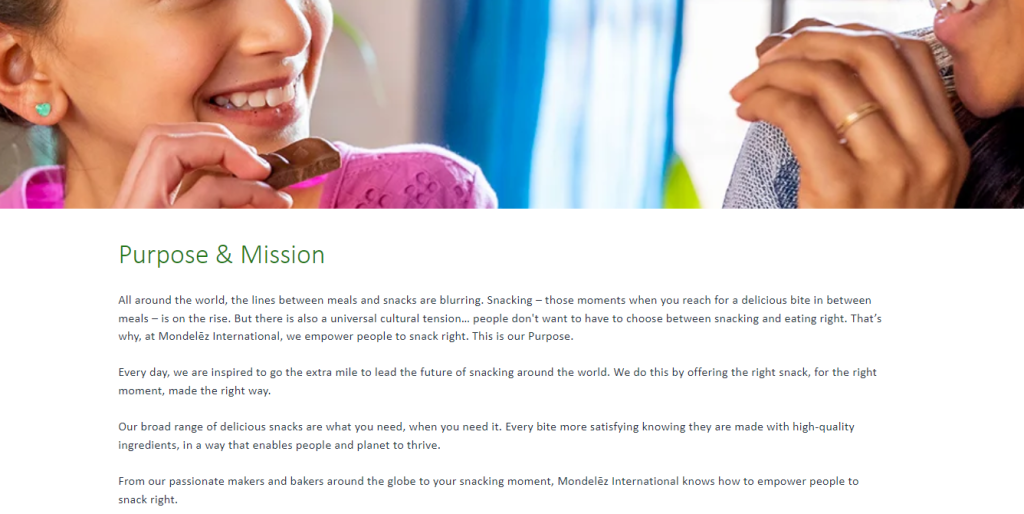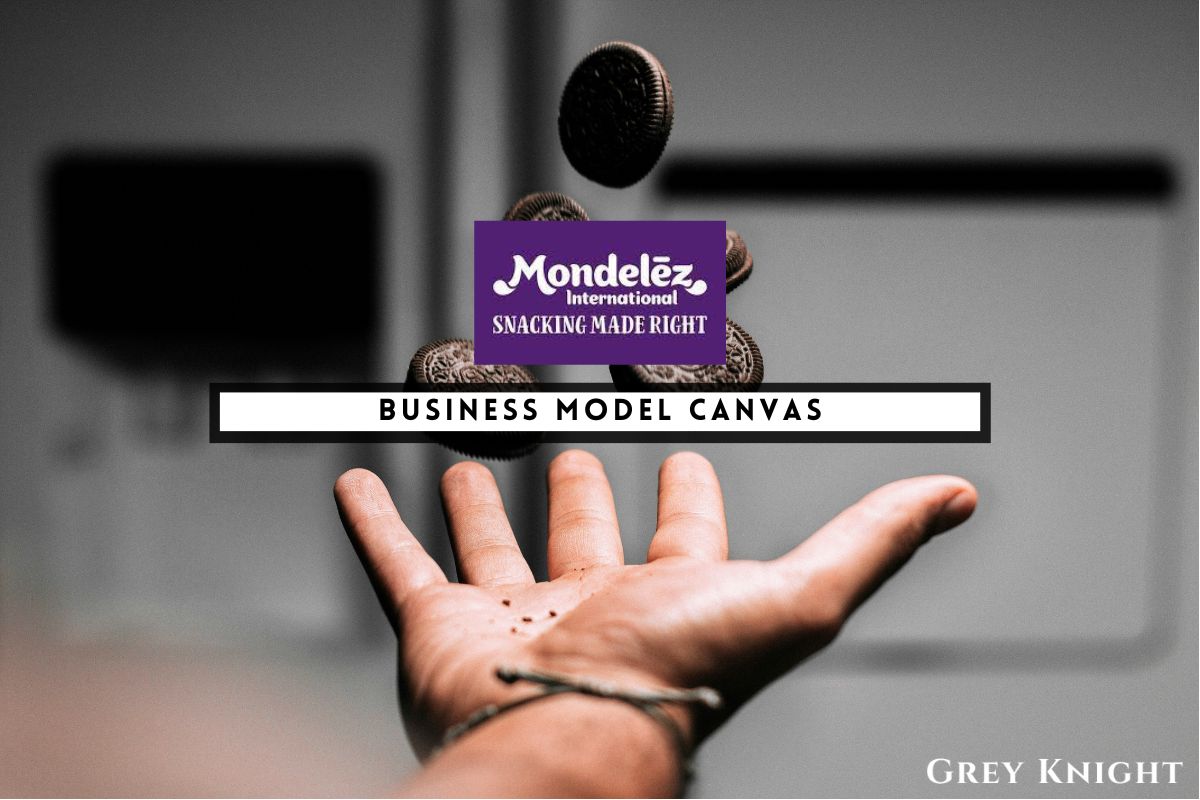Table of Contents
ToggleA Brief History of Mondelez
Mondelez International, Inc. is an American multinational food and beverage company. The company was established in 2012 as a spin-off from Kraft Foods, Inc., which itself was formed through the merger of Kraft and General Foods in 1989.
Mondelez International’s history can be traced back to the early 20th century when the National Dairy Products Corporation formed in 1923. Over the years, the company underwent several mergers and acquisitions and changed its name to Kraft Foods Inc. in 1988.
In 2012, Kraft Foods Inc. split into two separate companies, with the North American grocery business retaining the Kraft Foods Group, and the global snack and confectionery business becoming Mondelez International, Inc.
Since its inception, Mondelez International has continued to grow through acquisitions, partnerships, and product innovation. The company’s portfolio includes well-known brands such as Oreo, Cadbury, Milka, Toblerone, Trident, and Ritz, among others.
Today, Mondelez International operates in over 150 countries and employs thousands of people worldwide. The company continues to be a major player in the global food and beverage industry, contributing to its rich and diverse history.
Who Owns Mondelez?
Mondelez International, Inc. is a global snack and confectionery company that was formed in 2012 through the spin-off of Kraft Foods. The company is publicly traded on the NASDAQ stock exchange under the ticker symbol MDLZ. As a publicly traded company, Mondelez International is owned by a large number of shareholders, both institutional and individual. The top 10 shareholders of Mondelez International, Inc. are as follows: The Vanguard Group, BlackRock, Inc., State Street Corporation, Capital World Investors, Capital Research Global Investors, T. Rowe Price Associates, Wellington Management Company, L.L.P., Northern Trust Corporation, Geode Capital Management, LLC, and Franklin Resources, Inc. These top shareholders collectively hold a significant portion of the company’s outstanding shares and have a major influence on the company’s operations and strategic decisions.
Mondelez Mission Statement

Mondelez International, Inc. is a global snacking company that has a clear mission to create delicious moments of joy for their consumers. Their mission statement is centered around empowering people to snack right by offering a wide range of high-quality and responsibly made products. Mondelez International is committed to delivering sustainable and responsible growth, while also making a positive impact on the world and its communities. Their mission is to lead the future of snacking by providing innovative and delicious products that bring joy to millions of people around the world.
How Mondelez Makes Money?
Mondelez International, Inc. is a global snacking company that operates in over 150 countries. The company’s business model revolves around producing and selling a wide range of snack products, including cookies, chocolate, gum, and candy. Mondelez makes money primarily through the sale of its various snack brands, such as Oreo, Cadbury, and Trident, in retail channels, including grocery stores, convenience stores, and e-commerce platforms. The company also generates revenue through licensing and franchise agreements, as well as through strategic partnerships with other food and beverage companies. Additionally, Mondelez has a strong focus on innovation, regularly introducing new products to meet changing consumer preferences and to drive sales growth. Overall, the company’s diversified revenue stream and strong brand portfolio contribute to its success in the snacking industry.
Mondelez Business Model Canvas
The Business Model Canvas is a strategic management tool that provides a visual representation of a company’s business model. It consists of nine building blocks that help businesses understand their value proposition, customer segments, key activities, resources, partnerships, cost structure, and revenue streams.
Customer Segments:
Mondelez International, Inc. targets a wide range of customer segments, including consumers who purchase snacks and confectionery products, retailers who sell Mondelez’s products, and suppliers who provide raw materials for production.
Value Propositions:
Mondelez offers high-quality, innovative snacks and confectionery products that are available in a variety of flavors and formats, meeting diverse consumer needs and preferences. The company also focuses on sustainability and responsible sourcing, which can be a value proposition for environmentally conscious consumers.
– High-quality and innovative products
– Diverse range of flavors and formats
– Sustainability and responsible sourcing
Channels:
Mondelez distributes its products through various channels, including retail stores, supermarkets, convenience stores, online platforms, and vending machines. The company also has a strong presence in global markets, utilizing both direct and indirect distribution channels.
– Retail stores
– Supermarkets
– Convenience stores
– Online platforms
– Vending machines
Customer Relationships:
Mondelez maintains customer relationships through marketing and advertising, as well as through direct engagement with consumers and retail partners. The company also seeks to build brand loyalty and trust by delivering consistent quality and addressing consumer feedback.
– Marketing and advertising
– Direct engagement with consumers and retail partners
– Building brand loyalty and trust
Revenue Streams:
Mondelez generates revenue primarily through the sale of its snacks and confectionery products. The company also earns income from licensing and franchising agreements, as well as from contractual arrangements with suppliers and distribution partners.
– Sale of snacks and confectionery products
– Licensing and franchising agreements
– Contractual arrangements with suppliers and distribution partners
Key Resources:
Key resources for Mondelez include its manufacturing facilities, research and development capabilities, brands and trademarks, supply chain infrastructure, distribution network, and human capital.
– Manufacturing facilities
– Research and development capabilities
– Brands and trademarks
– Supply chain infrastructure
– Distribution network
– Human capital
Key Activities:
Mondelez’s key activities include product development, manufacturing and production, marketing and sales, supply chain management, quality control, and corporate governance and compliance.
– Product development
– Manufacturing and production
– Marketing and sales
– Supply chain management
– Quality control
– Corporate governance and compliance
Key Partners:
Mondelez collaborates with various key partners, including suppliers of raw materials, distribution and logistics companies, marketing and advertising agencies, retailers, and industry organizations. The company also partners with research institutions and universities for innovation and sustainability initiatives.
– Suppliers of raw materials
– Distribution and logistics companies
– Marketing and advertising agencies
– Retailers
– Industry organizations
– Research institutions and universities
Cost Structure:
Mondelez’s cost structure includes expenses related to raw materials and production, marketing and advertising, distribution and logistics, research and development, employee compensation, and administrative overheads.
– Raw materials and production
– Marketing and advertising
– Distribution and logistics
– Research and development
– Employee compensation
– Administrative overheads
Mondelez’s Competitors
Mondelez International, Inc. is a leading global snack and confectionery company, with a strong portfolio of well-known brands such as Oreo, Cadbury, and Ritz. The company’s top competitors in the snack and confectionery industry include:
1. PepsiCo, Inc. – Competes with Mondelez in the snack and beverage markets, with brands such as Lay’s and Tostitos.
2. The Hershey Company – A major competitor in the confectionery industry, known for its chocolate bars and candies.
3. Mars, Incorporated – Another key player in the confectionery market with popular brands like M&M’s and Snickers.
4. Nestlé S.A. – Competes with Mondelez in both the confectionery and the snack markets with brands like Kit Kat and Häagen-Dazs.
5. Kraft Heinz Company – As a major player in the food and beverage industry, Kraft Heinz competes with Mondelez in the snack and grocery markets with brands such as Philadelphia and Planters.
Mondelez SWOT Analysis
Strengths:
1. Strong global presence with a wide range of popular snack brands.
2. Diversified product portfolio catering to different consumer preferences.
3. Strong distribution network and strategic partnerships.
4. Focus on innovation and product development.
Weaknesses:
1. Dependence on a few key markets for a significant portion of its revenue.
2. Vulnerability to fluctuations in commodity prices and foreign exchange rates.
3. Limited presence in the health and wellness segment.
Opportunities:
1. Growing demand for snacking products in emerging markets.
2. Expansion into healthier snack options to cater to changing consumer preferences.
3. Acquisitions and partnerships to strengthen market position and product offerings.
Threats:
1. Intense competition from both large and small players in the snack industry.
2. Increasing regulations and scrutiny on the marketing and sale of unhealthy snacks.
3. Economic downturns and geopolitical tensions impacting consumer spending habits.
Concluding Analysis
In my analysis of Mondelez International, Inc., I have seen a company with a strong business model that has allowed it to thrive in the competitive consumer goods industry. The focus on innovation, strategic partnerships, and an efficient supply chain have been key factors in the company’s success. As an analyst, I believe that Mondelez International, Inc. is well-positioned for future growth and continued success. With a strong portfolio of iconic brands and a commitment to sustainability, I foresee the company’s business model continuing to adapt and evolve to meet the changing needs of consumers. Overall, I am optimistic about the future of Mondelez International, Inc. and see great potential for continued success in the years to come.
Additional Resources
To keep learning and advancing your career, we highly recommend these additional resources:
Business Model Canvas of The Top 1,000 Largest Companies by Market Cap in 2024
A List of 1000 Venture Capital Firms & Investors with LinkedIn Profiles
Peter Thiel and the 16 Unicorns: The Legacy of Thiel Fellowship












